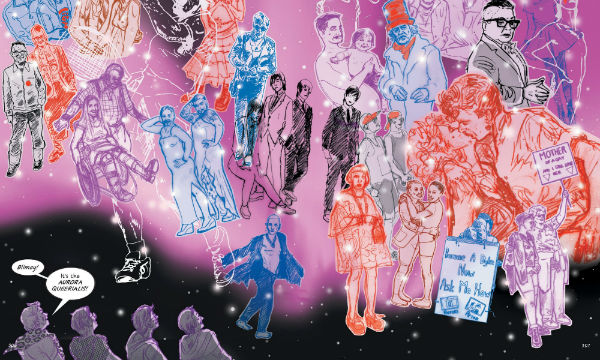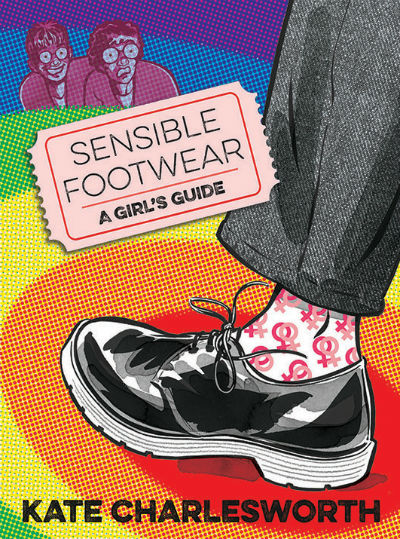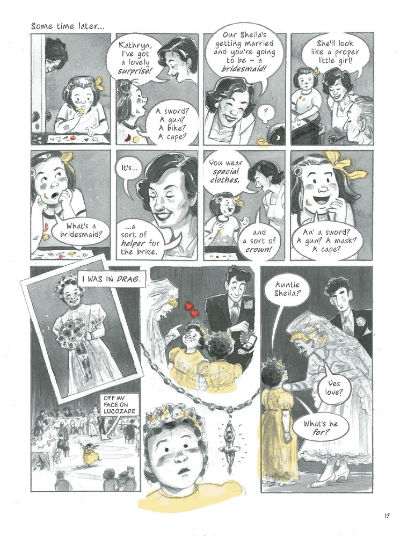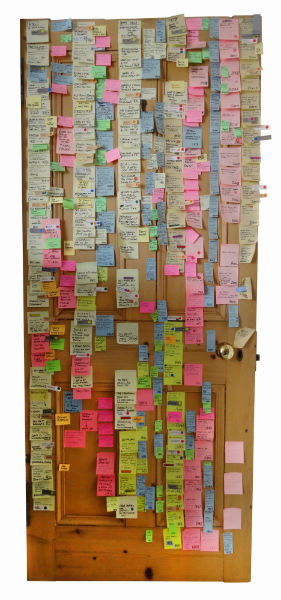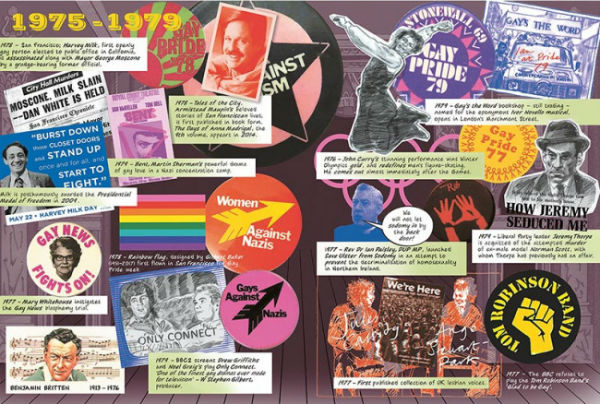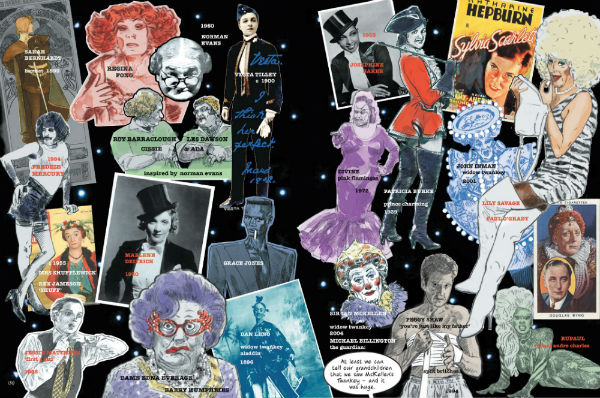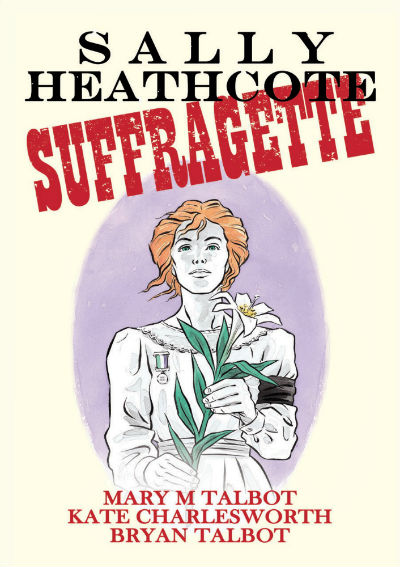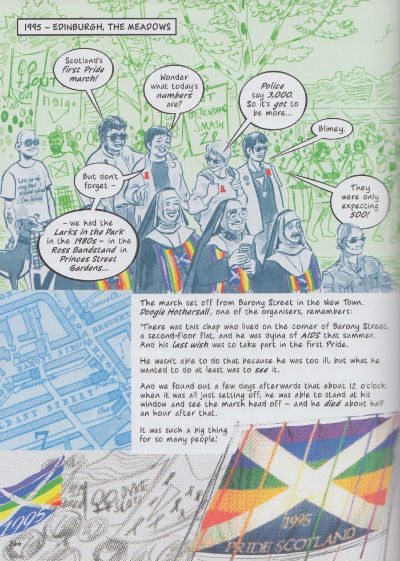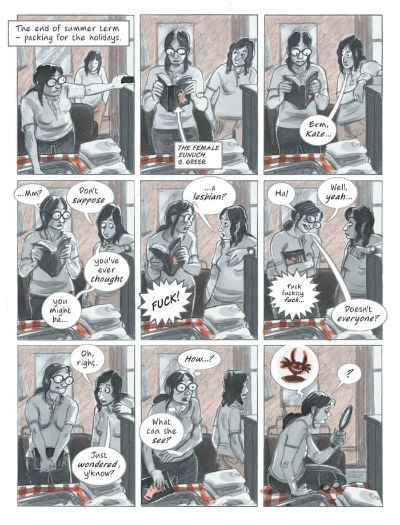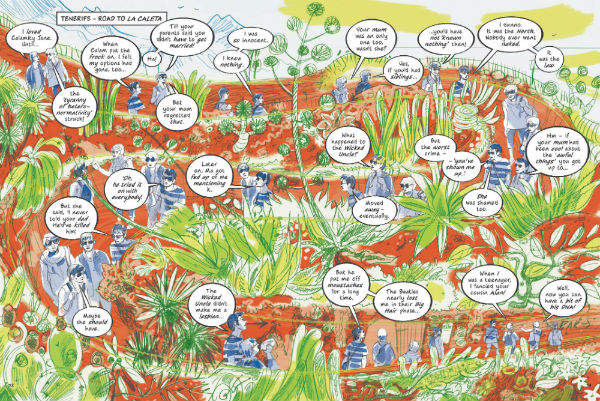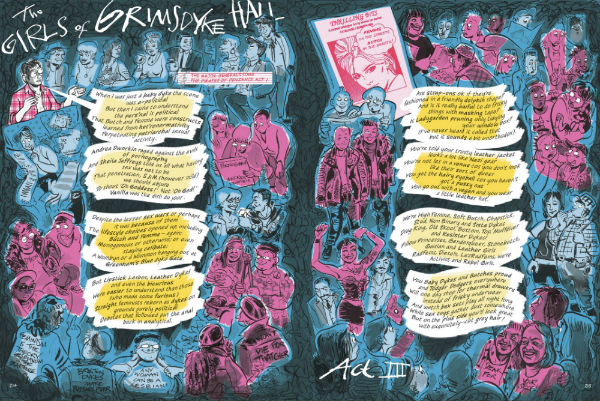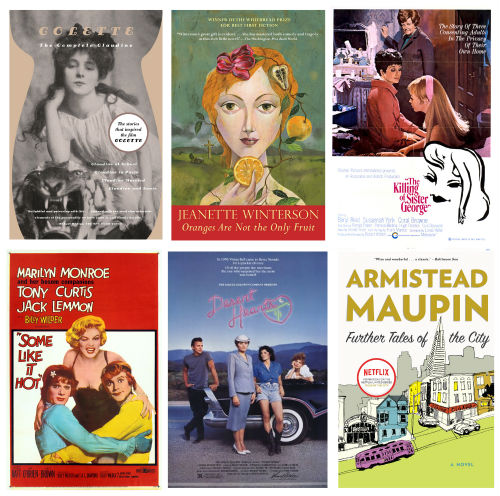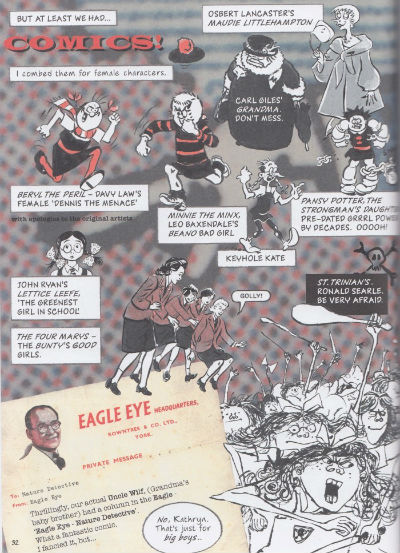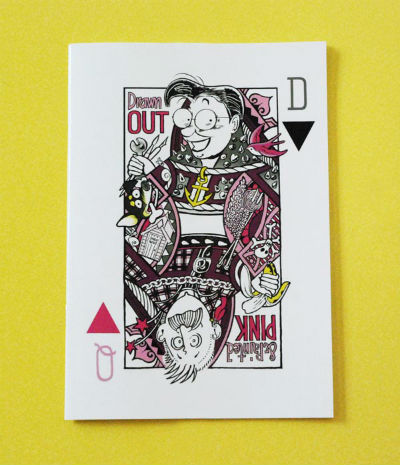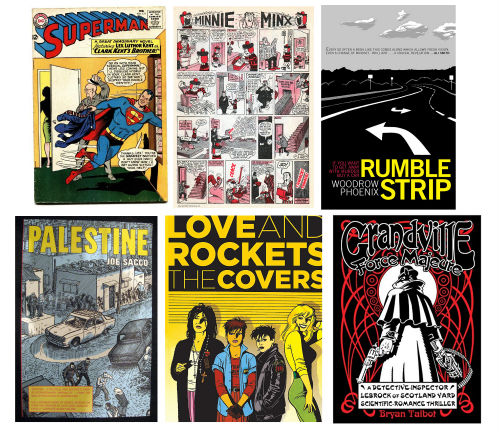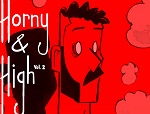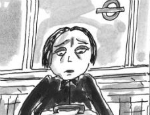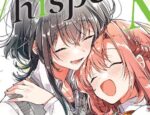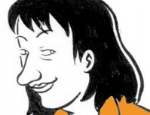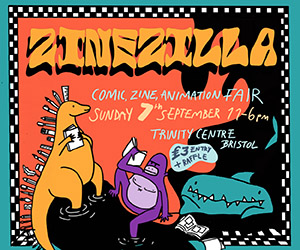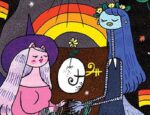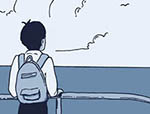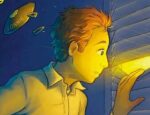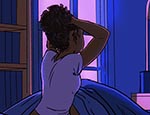“Not very long ago, to say that someone was the sort of woman who ‘prefers to wear sensible shoes’ could imply that she was a lesbian” Even more recently, Kate Charlesworth’s graphic work of the same name was released, to shed technicolour light on the subject from her expert angle.
Kate Charlesworth has worked in cartooning and illustration since the 1970s, much of it for various incarnations of LGBTQ+ press the likes of The Pink Paper, Gay News and AARGH, as well as comics for New Scientist and The Independent. In the last decade, she’s produced non-fiction graphic novels Sally Heathcote: Suffragette with Mary and Bryan Talbot at Dark Horse and The Cartoon History of Time with John Gribbin; Dover Publications and contributed to the Nelson anthology.
Sensible Footwear – A Girl’s Guide is the first full length graphic novel she’s produced solo and it’s a tour de force of visual communication. Interweaving autobiographical stories with info packed pages of cultural, legal and local history, Charlesworth’s readable, personable book provides a much needed insight into an under-represented perspective on British life. Jenny Robins caught up with her to talk all things gay and graphic.
BROKEN FRONTIER: Please can you briefly introduce the book and explain the title?
KATE CHARLESWORTH: Sensible Footwear – A Girl’s Guide is a personal memoir/graphic LGBT+ history of Britain, with the emphasis on the L, spanning 1950 to 2019 (i.e., publication).
Not very long ago, to say that someone was the sort of woman who ‘prefers to wear sensible shoes’ could imply that she was, or looked as though she might be, a lesbian. In America, the phrase was ‘comfortable shoes’.
BF: Sensible Footwear is a mammoth achievement, weaving detail-heavy history with personal journey in a myriad (pun intended) of styles that yet manages to hang together beautifully and feel like a cohesive whole. The Cartoon Museum showed images of your infamous big planning wall of post-its. How did you settle on the balance and structure you ended up with? And what were the hardest decisions along the way?
CHARLESWORTH: I wanted to make a book which would run more or less in chronological order, include as much information as I possibly could from a ridiculously huge field, and still make a readable, page-turning story.
I grouped the information (though I barely scratched the surface) into different strands, to be arranged and or interwoven, into a single layered narrative – underpinned by time, place, connections, coincidence.
I.e., two major strands – my personal memoir and the whole of LGBT+ history complemented by special content features and recurring themes, which punctuate and/or extend the main narratives, and reinforce continuity and depth.
The hardest decisions – deciding which personal and historical stories and characters had to be left out. It’s a big book, but it’s not that big…
BF: Do you think this is a book that had to be a comic? What about the medium lent itself to the project?
CHARLESWORTH: Yes, I do. Obviously because I’m a graphic artist, and I’ve written and drawn jokes and strips for years and years – but also because I’m telling very visual stories. The lost worlds of the 50s, 60s and 70s; moving towards the digital age; the camp, the glitz, the anger; the communities, the friendships. And because I wanted to use a huge amount of visual material – historical ephemera – badges, images, printed material, and hundreds of photographs rendered as drawn images.
And because it covers such a lot of ground on so many fronts, text alone would be a long, and possibly gruelling, read.
BF: How does Sensible Footwear compare to your other comic work over the years?
CHARLESWORTH: When I worked on Sally Heathcote – Suffragette (Cape, 2014) with Bryan and Mary Talbot, I’d first intended to use pen and ink. Plan A quickly changed to ink brush and wash when I realised how much cross-hatching I’d have to do, and Plan B worked remarkably well.
So whilst not intending to work quite in that style on Footwear, Sally’s was certainly an influence on much of Footwear’s content – memoir in particular.
And as I compiled the big history pages I realised the way had been paved for realistic drawings and ‘fascinating facts’ in the years I’d worked for New Scientist magazine – particularly on my strip Life, the Universe and (Almost) Everything (1988-2001).
BF: As someone that’s lived in London, grew up somewhat north of the capital and has also been long based in Scotland, how do the comic (and queer) scenes compare?
CHARLESWORTH: To be honest, a combination of decades working more or less in isolation, plus that generational thing hasn’t left me in the best place to properly comment. As a freelance cartoonist (and illustrator) I was on the indie fringes for years, and my involvement in comics has only increased over the last couple of decades. I know there’s a flourishing zine and comics scene here in Scotland, so I presume the same for London. And there’s Laydeez do Comics, who are terrific, not women-only, and not just London-centric.
I was in Finland a few weeks ago at the Helsinki Comics Festival with Myriad’s Corinne Pearlman. We loved it, but we were both blown away by the vibrancy and quality of the indie zine scene there. So many young women involved, too.
BF: What processes/software did you use to create this book?
CHARLESWORTH: A combination of drawing, painting and digital. Some pages drawn from scratch, with a bit of clean-up in Photoshop, others (such as the big history spreads) built up on screen from drawings I’d made, scanned elements, etc. I only use Photoshop. The thought of learning Illustrator (or anything else) makes me want to lie down in a dark cave with a strong drink.
BF: I know the feeling! How did you choose the various stylistic approaches and colour palettes in the book? Did you set yourself rules, or work mainly by instinct? Which styles were the most fun to work in?
CHARLESWORTH: Sort of instinctive rules… I knew I wanted to start in pencil, with wash, in the 1950s (I thought it might be quicker, too. Sometimes it was). By the 70s I changed over to ink and wash.
I enjoyed Photoshopping ready-made elements – fabric textures, for instance.
And I’m fond of spot colour – and a restricted palette.
I also wanted to incorporate a looser drawing style – mostly in pencil, sometimes verging on the stylised, the ‘artistic’ but I enjoyed giving that basic ‘handwriting’ full rein. When time was running short I sometimes used the original rough pencils – so often you can’t replicate that first drawing, so I decided to just go with them.
The narrative’s opening features a ‘real time’ Ancient Greek chorus of four friends, one long conversation which takes place on one day in 2016. It appears intermittently throughout the book, and for this I digitally rendered pencils to achieve a sort of Riso/1950s litho feel, which gave an obvious contrast to whatever the surrounding pages contained. I really liked that.
By the nature of the book I was committed to depicting hundreds of real people, situations, artefacts. This was especially important regarding historic content. I was also committed to representing all of the above (and my own memoir) as faithfully as I could – (I wasn’t interested in caricaturing individuals, even if that was my forté, which it isn’t) – I was aiming at layers of veracity, along with the content, and so for this reason (and for speed, and for circumventing copyright issues) I decided to use a good quick trace of photographs, adding loose layer of wash texture. It worked, it was satisfying, and it gave the book an extra element of cohesion.
I used loose pen and ink on occasion – usually in a more ‘cartoony’ fashion – The Girls of Grimsdyke Hall, for instance. That was fun.
BF: I loved how the book explores queer culture through both your personal experience as a lesbian and a wider lens. The idea that some cultural output is just inherently queer, even if it doesn’t contain any explicitly LGBTQ+ content, and the instinct for recognising that is really interesting and feels very true to me. You touch on how the solidarity between communities and labels is both stronger than ever before and diluted by contemporary culture, I’m sure I’m getting to a question here somewhere, oh yes, what core films/books/comics etc. (other than this one) would you recommend to young people today to best give them an understanding of that history of queer identity when it was less mainstream?
CHARLESWORTH: Ha ha! Hm. Books… As a teenager, I obsessively read anything by Colette, a bisexual French novelist, writing in the earlier years of the 20th century – who’d had quite a life. I loved her Claudine stories – about a rather daring schoolgirl’s frisky – and sensual – exploits.
Rushing forward in time, Janette Winterson’s fabulous Oranges Are Not the Only Fruit (1985) is an autobiographical account of the author’s titanic struggle, as a young lesbian, with her deeply eccentric, religious, force-of-nature mother. A true classic. And it’s sequel – Why be Happy When You Could be Normal? (2011). Brilliant.
Films – Watch The Killing of Sister George. Because this is all there was (outwith porn cinemas) about lesbians in 1968, even if it was wildly inaccurate. And for an idea of queer camp (and remember, this came from homo-free (ahem) Hollywood in 1959) watch Some Like it Hot, with Maryln Monroe – very queer, very funny. The. Best. Film. In. The. World.
Desert Hearts – book (Jane Rule) and film (1985)
All of Armistead Maupin’s Tales of the City, it’s American, and set for the most part in San Francisco – a really lovely read, from 1978 – 2014.
Oh, lots.
BF: What a great list! (Broken Frontier acknowledges other films may be considered the best in the world by our readers). I got excited for a moment thinking that the Claudine books you mentioned likely inspired the 1970s transgender shōjo manga of the same name – though Wikipedia thinks not. Do you feel that lesbian history specifically is still a vastly under-serviced subject? What would you like to see more of? Or are there other areas that you think needs even more attention?
CHARLESWORTH: Well… there’s lots of academic stuff out there, and more coming along, necessary writings. I think there’s a growing upsurge of interest in lesbian history – but what I think really does need attention are individual stories – not just of older women, but all ages, and these should be collected as soon as possible. I think (or I hope) it’s happening more with younger people – blogs, net comics. Where do dykes meet now? There are fewer dedicated spaces. And as long as women are undervalued by society (and by extension, dykes even more so) we’ll always be at risk of being lost to history.
The interviewer held a moment of silence at this point for Candy Bar and Bar Titania, formerly of Soho. Readers may wish to hold their own personal vigils.
BF: I also thought the ending was particularly well paced, bringing together the threads of the book very nicely – did it take a lot of planning to get it to flow like that? Did the ending have any other incarnations that ended up on the post-it room floor?
CHARLESWORTH: Thank you. Yes, it took quite a while to work out the plan; how to place and pace the information, textually and visually – and how best to depict the last sequence – it looks obvious now, but it took quite a few goes.
Only alternative visuals ended up on the floor; the words is how I remember them being spoken at the time. Something I could never forget… I can’t say any more. No spoiler!
BF: What are you working on next/now?
CHARLESWORTH: I’m thinking about a few things – but very early days – in between book-related events, and there have been a lot. I can’t say much more than that, either!
I’m also trying to re-order the house – my workroom; several years’ stuff has accumulated whilst I’ve been working on the book, and only now do I have time to chuck things out.
So if anyone out there wants incomplete sets of Gay News and the Pink Paper, see me.
BF: What are your all-time favourite comics and graphic novels?
CHARLESWORTH: I suppose when comics gave me the biggest thrill was in the mid-1960s. I’d been quite ill, and a relative gave me three or four Superman DC comics. I was completely hooked, and I found I could buy them second hand on the local market – and new, at the newsagents. All gone now, alas. I had shedloads, including annuals…
Any Leo Baxendale comics…
I think Woodrow Phoenix’s Rumble Strip is genius.
Joe Sacco’s Palestine, et al, and his ‘First Day of the Battle of the Somme’ – a 24-foot panorama – is just stunning.
Love and Rockets, Los Bros Hernandez; Bryan Talbot’s Grandville Saga, and so much more by him – and Mary. I’m looking forward to a copy of their latest, Rain, very soon.
And I have a pile of graphic novels still to be read. The trouble with doing one means you don’t have much time to read anyone else’s. So I’m looking forward to loads more to come: the second two in Rob Davis’ Motherless Oven trilogy, for instance, and Spinning, by Tillie Walden.
BF: Another extremely great list. Thank you so much for the time taken to answer these questions!
Sensible Footwear can be purchased from the Myriad website here or from your favourite retailer.





